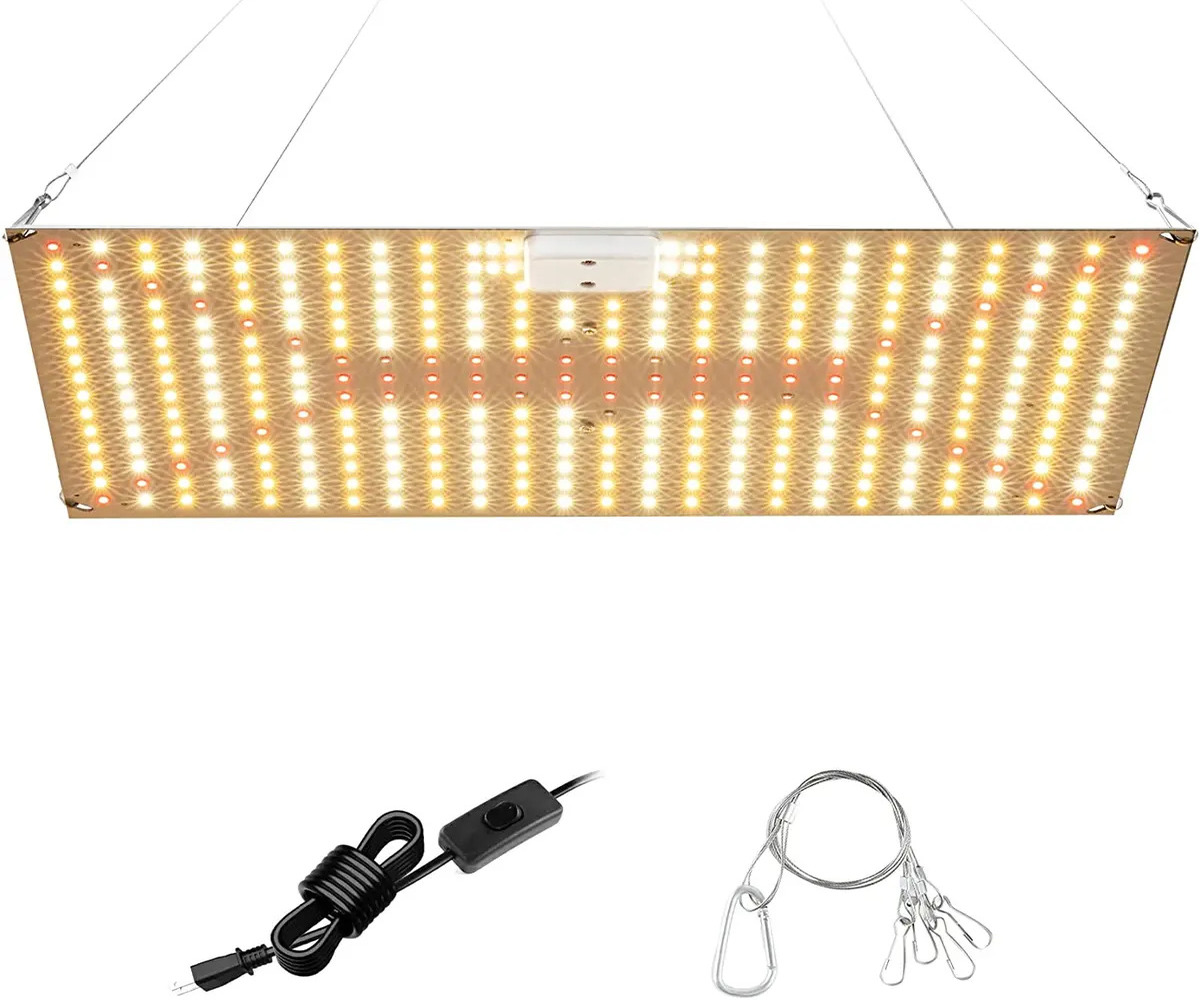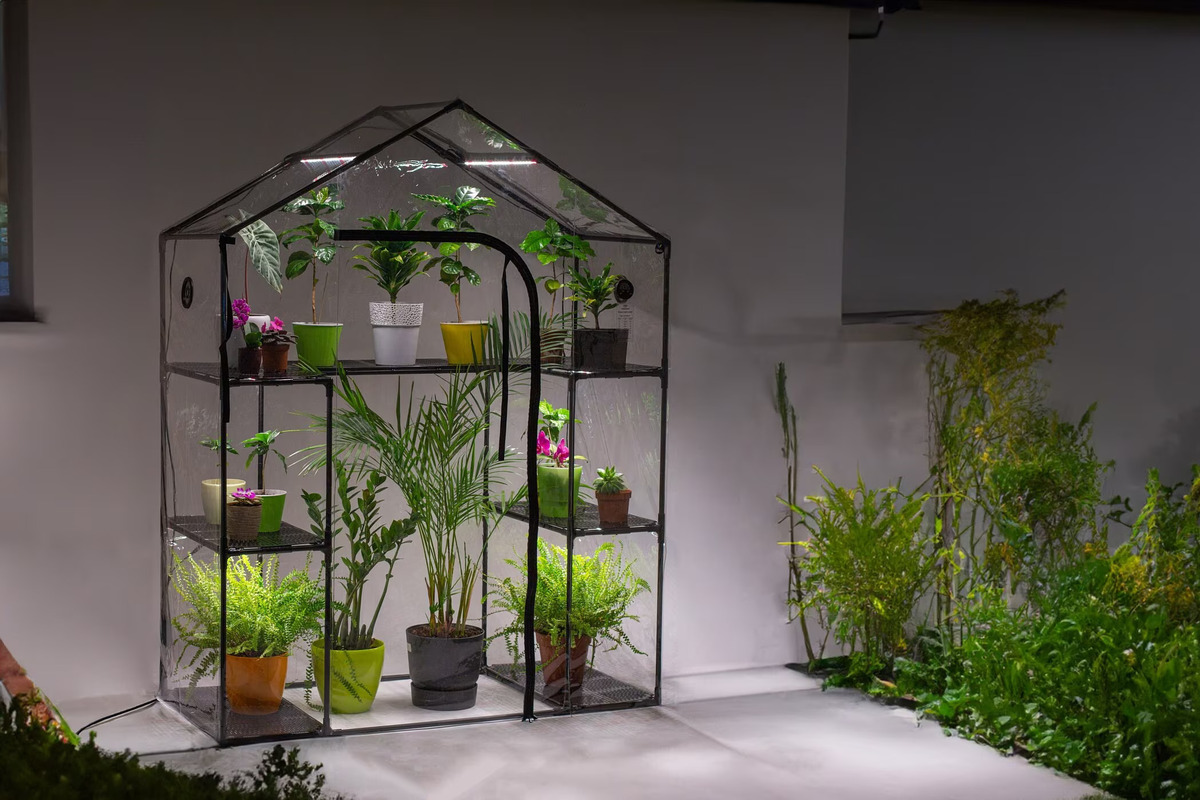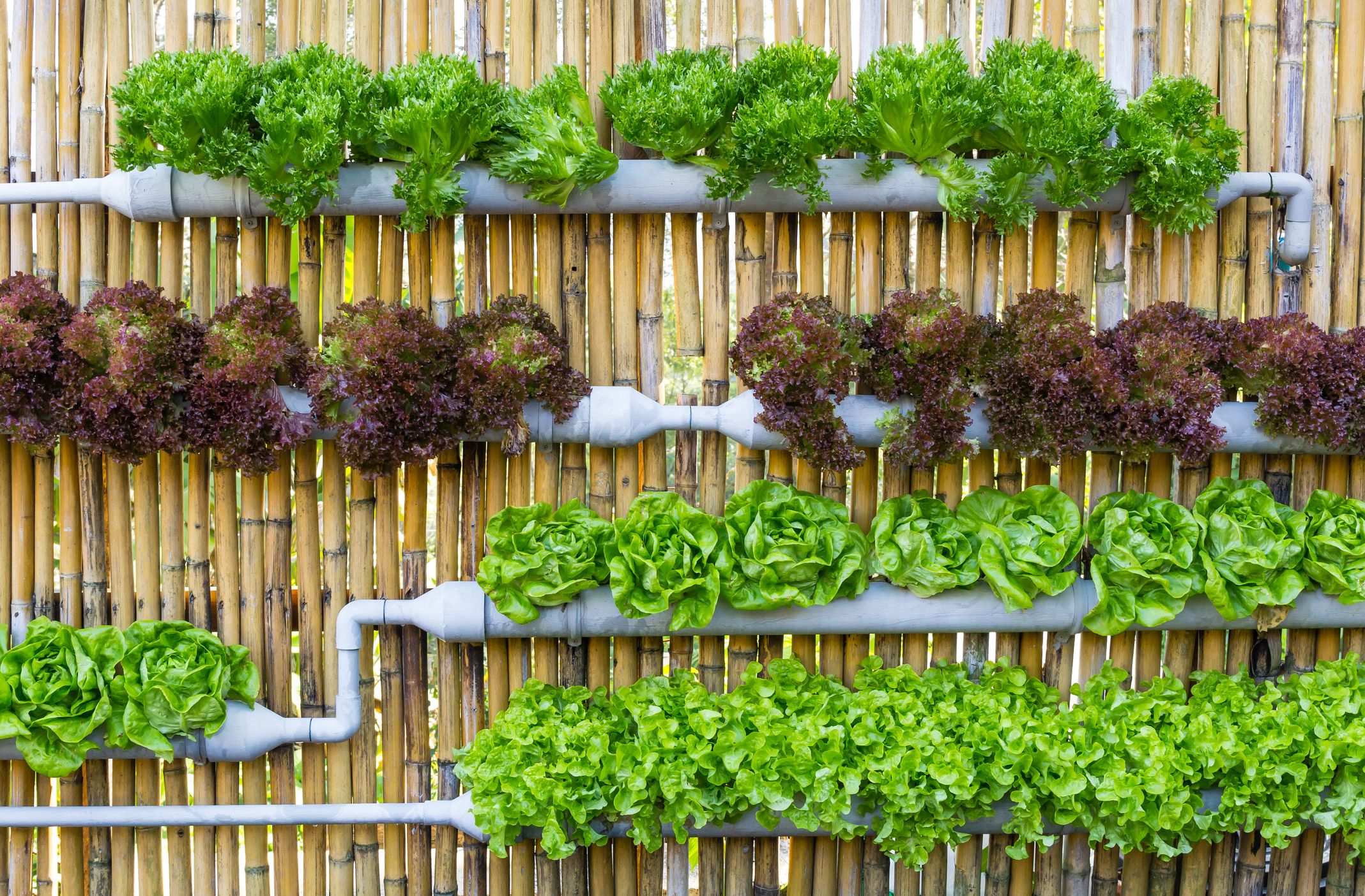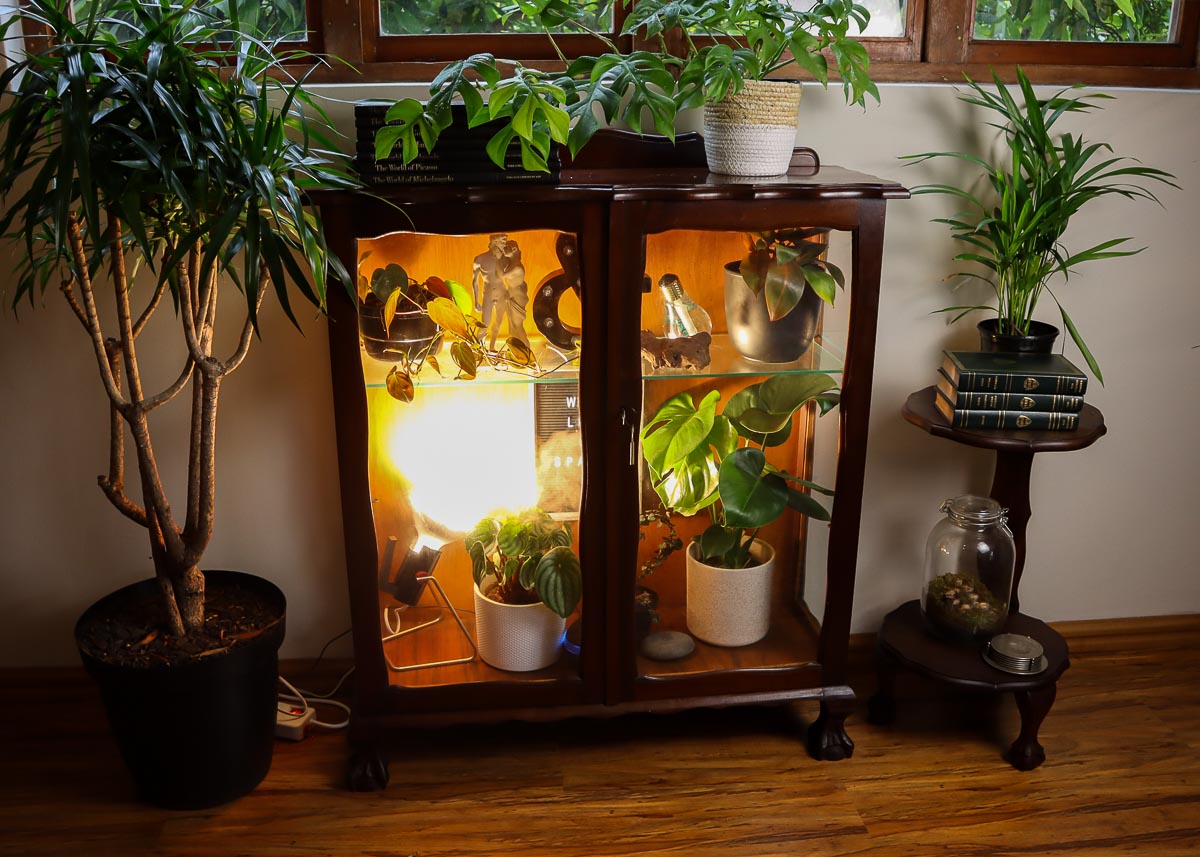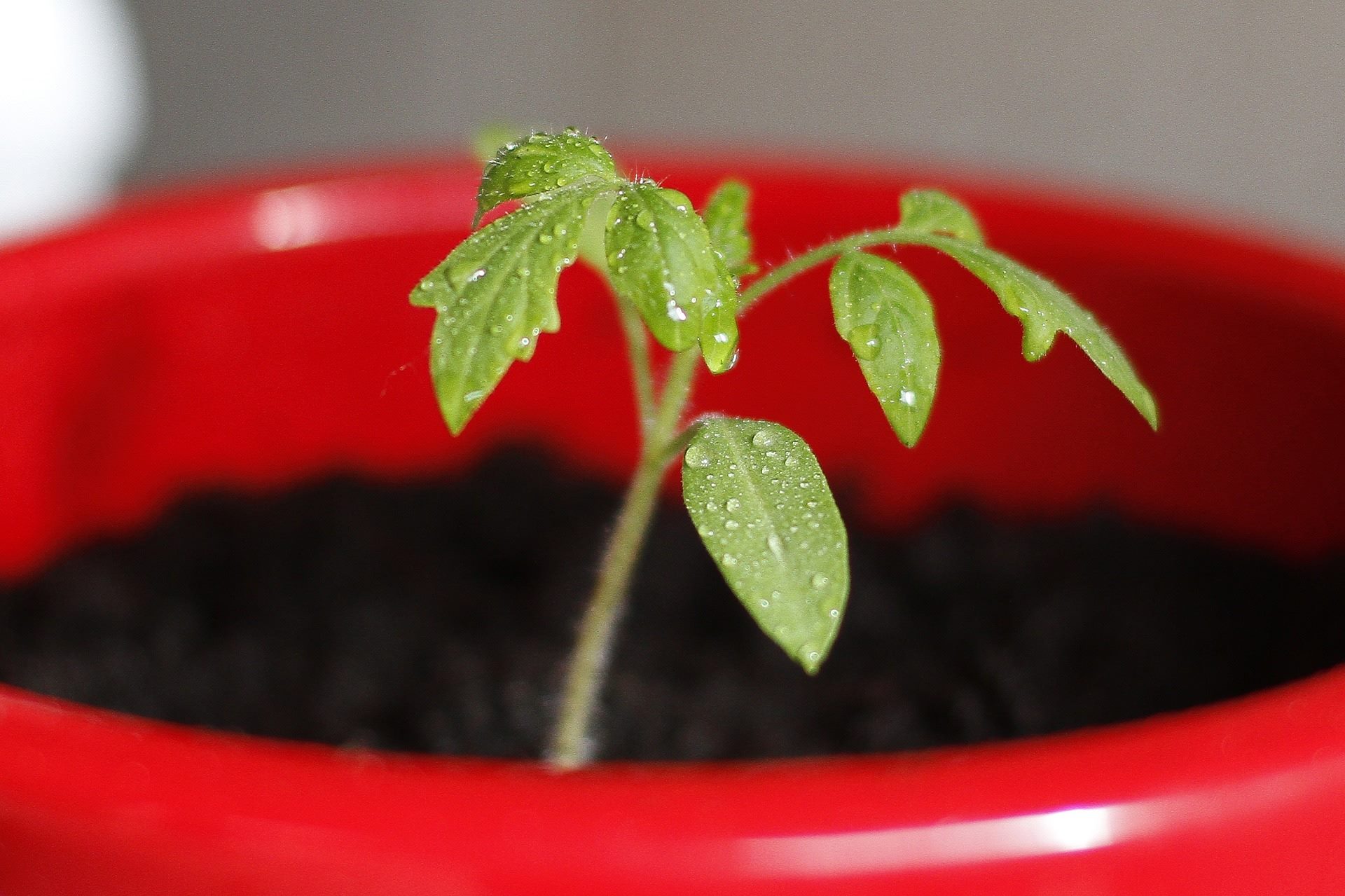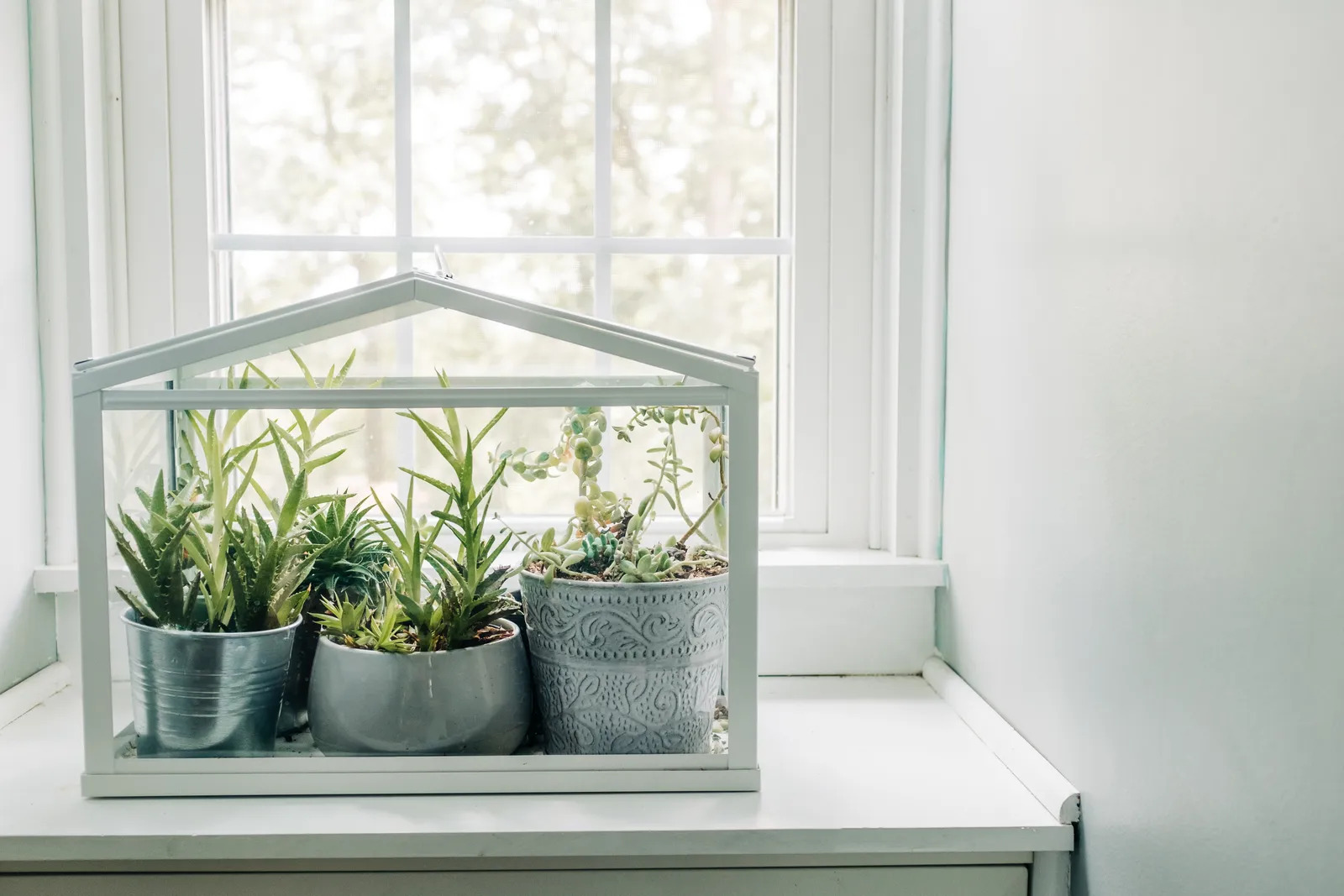Home>Gardening Techniques>DIY Projects>How To Make Indoor Greenhouse
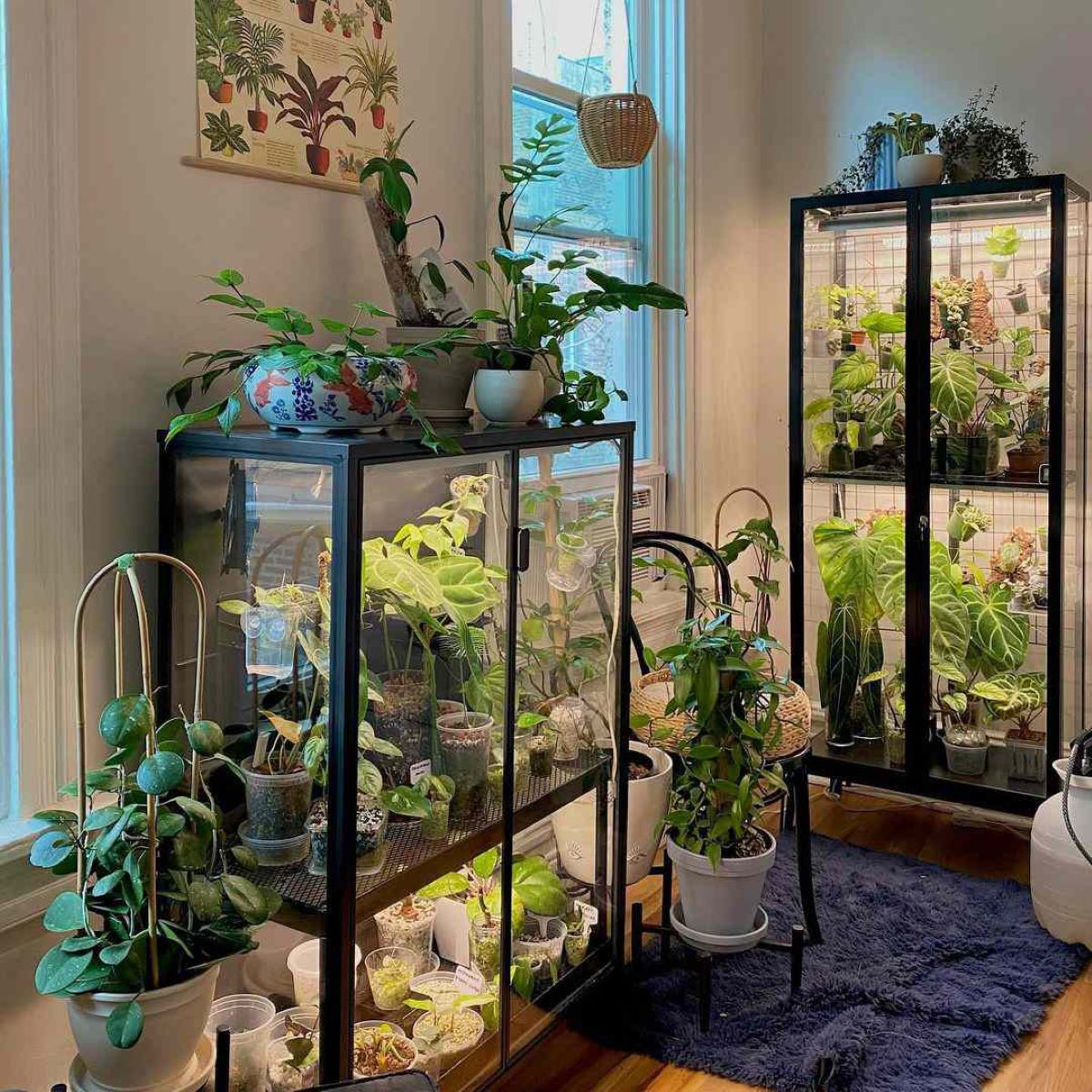

DIY Projects
How To Make Indoor Greenhouse
Modified: February 10, 2024
Learn how to create your own indoor greenhouse with this step-by-step DIY project guide. Grow your favorite plants all year round!
(Many of the links in this article redirect to a specific reviewed product. Your purchase of these products through affiliate links helps to generate commission for Chicagolandgardening.com, at no extra cost. Learn more)
Table of Contents
- Introduction
- Benefits of Indoor Greenhouses
- Choosing the Right Location
- Selecting the Right Plants
- Setting Up the Greenhouse Structure
- Providing Adequate Ventilation
- Controlling Temperature and Humidity
- Choosing the Right Lighting
- Watering and Fertilizing
- Monitoring Pests and Diseases
- Common Mistakes to Avoid
- Conclusion
Introduction
Welcome to the world of indoor gardening! Creating your very own indoor greenhouse is a rewarding and fulfilling DIY project that allows you to enjoy the benefits of gardening all year long, regardless of the weather outside. Whether you have limited space, live in an apartment, or simply want to bring a touch of nature indoors, an indoor greenhouse is the perfect solution.
Indoor greenhouses provide a controlled environment where you can grow a variety of plants, from herbs and vegetables to beautiful flowers and succulents. Not only do they add beauty and vibrancy to your living space, but they also offer numerous benefits for your health and well-being.
One of the key advantages of indoor greenhouses is the ability to extend the growing season. With an indoor setup, you are no longer limited by the seasons, allowing you to grow your favorite plants year-round. This is especially beneficial for those living in colder climates where outdoor gardening is often restricted to a few months.
Furthermore, indoor greenhouses provide a protected environment for your plants, shielding them from extreme weather conditions, pests, and diseases. You have complete control over the growing conditions, including temperature, humidity, and lighting, ensuring optimal growth and maximizing yields.
Indoor greenhouses also offer great flexibility in terms of space. Even if you have limited square footage, there are various options available, such as vertical gardening or compact setups, that allow you to make the most of your available space. This makes indoor gardening accessible to everyone, regardless of the size of their living quarters.
Lastly, gardening has been proven to have a positive impact on mental health and overall well-being. Spending time with plants can reduce stress, improve mood, and increase feelings of relaxation. Having an indoor greenhouse allows you to immerse yourself in nature, even if you don’t have access to a backyard or garden.
In this comprehensive guide, we will walk you through the process of creating your own indoor greenhouse, from selecting the right location and plants to setting up the structure, providing proper ventilation and lighting, and taking care of your plants. So, let’s get started and dive into the wonderful world of indoor gardening!
Benefits of Indoor Greenhouses
Indoor greenhouses offer a multitude of benefits for both experienced gardeners and beginners alike. Let’s explore some of the key advantages of creating your own indoor gardening space.
Year-round gardening: One of the greatest advantages of indoor greenhouses is the ability to grow plants throughout the year, regardless of the external climate. With an indoor setup, you can cultivate a wide range of plants, including herbs, vegetables, flowers, and even tropical species that require a consistent temperature and humidity level.
Protection from harsh weather: Outdoor gardening is often at the mercy of unpredictable weather conditions, such as extreme heat, cold snaps, heavy rains, or strong winds. Indoor greenhouses provide a controlled environment, protecting your plants from such weather fluctuations, ensuring their health and survival.
Pest and disease control: Indoor gardening reduces the risk of insect pests and plant diseases, as you can closely monitor and control the environment. By keeping your plants indoors, you significantly lower the chances of infestations and outbreaks, leading to healthier and more productive plants.
Optimal growth conditions: With an indoor greenhouse, you have complete control over the growing conditions. You can adjust the temperature, humidity, and lighting to match the specific requirements of your plants. This customization ensures optimal growth and maximizes yields.
Space optimization: Indoor greenhouses are a great solution for those with limited space. With vertical gardening techniques and compact setups, you can make the most of your available space. You can create a thriving garden in small apartments, balconies, or even on kitchen countertops.
Year-round access to fresh produce: Harvesting your own fresh herbs, vegetables, and fruits is not only rewarding but also allows you to enjoy nutritious and flavorful produce all year long. By growing your own food indoors, you can have a continuous supply of homegrown goodness, free from pesticides and other harmful chemicals.
Promotes mental well-being: Indoor greenhouses offer more than just physical benefits. Gardening has been proven to have a positive impact on mental health, reducing stress, anxiety, and depression. Taking care of plants and being surrounded by greenery provides a calming and therapeutic experience.
Enhances indoor aesthetics: Indoor greenhouses add a touch of natural beauty to your living spaces. Lush green plants and colorful blooms create a visually appealing environment, making your home feel fresh and inviting. Indoor gardening allows you to bring nature indoors, even if you don’t have a garden or backyard.
These are just a few of the many benefits of creating an indoor greenhouse. From year-round gardening to improved well-being, indoor greenhouses offer a multitude of advantages that make them an excellent choice for any plant lover or aspiring gardener.
Choosing the Right Location
Choosing the right location for your indoor greenhouse is crucial for the success of your plants. Here are some key factors to consider:
Sunlight exposure: Most plants require adequate sunlight for photosynthesis and healthy growth. When selecting a location, choose an area that receives sufficient natural light. South-facing windows are ideal as they provide the most sunlight throughout the day. However, if natural light is limited, consider using artificial grow lights to supplement the lighting needs of your plants.
Temperature considerations: Different plants have different temperature preferences. It’s important to select a location where the temperature remains within the optimal range for your chosen plants. Avoid placing your indoor greenhouse near drafty windows or doors, as these can cause temperature fluctuations. Remember to also factor in the ambient temperature of your home when determining the ideal location.
Humidity levels: Indoor greenhouses typically have higher humidity levels than the rest of the house. Choose a location that can handle increased humidity without causing moisture problems, such as mold or mildew. Bathrooms or laundry rooms with proper ventilation can be suitable options, or you can invest in a dehumidifier to control humidity levels.
Space availability: Consider the size of the indoor greenhouse setup you intend to create and ensure you have sufficient space available. Measure the area carefully and take into account any shelves, tables, or racks that may be required for your plants. You’ll want to ensure that there is enough space for proper air circulation around the plants as well.
Accessibility: Make sure the location you choose is easily accessible for tasks such as watering, pruning, and harvesting. If the area is difficult to reach or too cramped, it can make caring for your plants a challenge. Prioritize convenience and create a space that is easily manageable and enjoyable to work in.
Aesthetics: While functionality is important, don’t forget about the aesthetics. Your indoor greenhouse will be a part of your living space, so select a location that enhances the overall interior design. Consider plants that complement your existing décor and create an inviting and visually appealing display.
By considering these factors, you can choose a location that meets the needs of your plants, fits seamlessly into your home, and allows for easy maintenance and care. Remember that finding the right location is the foundation for a thriving indoor greenhouse.
Selecting the Right Plants
Choosing the right plants for your indoor greenhouse is essential to ensure their successful growth and longevity. Here are some factors to consider when selecting plants:
Light requirements: Different plants have varying light requirements. Some thrive in bright, direct sunlight, while others prefer indirect or low light conditions. Assess the amount of natural light available in your chosen location and choose plants that match those light levels. If your space lacks natural light, consider plants that can thrive under artificial grow lights.
Space availability: Consider the size and growth habits of the plants you want to grow. Choose plants that will fit comfortably within your indoor greenhouse space without overcrowding. Compact or bushy plants are ideal for smaller spaces, while climbing plants may require trellises or supports for vertical growth.
Temperature and humidity preferences: Different plants have specific temperature and humidity requirements. Some prefer cool conditions, while others thrive in warm and humid environments. Ensure that your chosen plants can tolerate the temperature fluctuations and humidity levels in your indoor greenhouse. Grouping plants with similar requirements together is also beneficial.
Watering needs: Consider your ability to properly water the plants you select. Some plants require more frequent watering, while others prefer drier soil. Take into account your schedule and lifestyle when choosing plants that match your watering capabilities. Alternatively, you can opt for low-maintenance plants that can tolerate some neglect.
Plant purpose: Determine the purpose of your indoor greenhouse. Are you looking to grow herbs for cooking, vegetables for fresh produce, or flowers for decoration? Tailor your plant selection to meet your goals and preferences. Consider the edibility, fragrance, or aesthetic appeal of the plants you choose.
Experience level: Assess your level of gardening experience when selecting plants. If you’re a beginner, start with easy-to-grow plants that are more forgiving of minor mistakes. As you gain confidence and knowledge, you can gradually introduce more challenging plant varieties into your indoor greenhouse.
Pest and disease resistance: Some plants are more susceptible to pests and diseases than others. Choose plants that have a reputation for being resilient and resistant to common indoor garden pests. This will help minimize the need for pesticides and reduce the risk of plant damage.
Personal preferences: Lastly, consider your personal preferences and tastes when selecting plants. Choose plants that you find visually appealing or that align with your preferred color schemes. Gardening should also bring you joy, so selecting plants that you love will enhance your overall indoor gardening experience.
By considering these factors, you can select the right plants for your indoor greenhouse that will thrive in the available conditions and match your gardening goals and preferences. Remember to also regularly assess the health and needs of your plants to ensure they continue to thrive and flourish.
Setting Up the Greenhouse Structure
Once you’ve chosen the location for your indoor greenhouse, it’s time to set up the structure. The structure provides the foundation for your plants and plays a vital role in their growth and well-being. Here are the key steps to consider when setting up your greenhouse structure:
Selecting a greenhouse type: There are several types of greenhouse structures to choose from, including freestanding, lean-to, and tabletop greenhouses. The type you choose will depend on the available space, your budget, and the number and size of plants you plan to grow. Consider factors such as ventilation, insulation, and durability when selecting a greenhouse type.
Choosing materials: Greenhouse structures can be made from a variety of materials, including glass, polycarbonate, or plastic. Each material has its own advantages and considerations, such as durability, insulation properties, and cost. Consider factors like the amount of natural light the material allows to penetrate and the ability to control temperature and humidity levels.
Ensuring proper drainage: Adequate drainage is crucial to prevent waterlogging and root rot. Choose a greenhouse structure that allows for proper water drainage, such as including drainage holes in containers or ensuring the greenhouse benches have proper airflow for water runoff.
Creating shelving or benches: Greenhouse shelving or benches provide optimal space for arranging your plants and ensuring good airflow around them. Utilize shelves or benches made from materials that can withstand high humidity levels and water exposure, such as plastic or coated metal. Consider the weight-bearing capacity of the shelves and adjust the height to accommodate different plant sizes.
Installing proper ventilation: Ventilation is essential to maintain fresh air circulation and prevent the buildup of excess humidity, which can lead to mold and disease. Install ventilation systems, such as fans or vents, to provide adequate airflow within the greenhouse. This will help regulate temperature and humidity levels, ensuring optimal plant growth.
Creating a microclimate: Some plants may require specific microclimate conditions, such as higher humidity or warmer temperatures. You can create mini microclimates within your greenhouse by using humidifiers, heaters, or heat mats to provide the necessary conditions for specific plants.
Organizing plant arrangement: Plan the arrangement of your plants strategically to make the most efficient use of space and provide optimal growing conditions. Consider factors like plant height, light requirements, and growth habits when organizing your plants. This will help ensure that each plant receives adequate light and space for growth while avoiding overcrowding.
Installing shading and insulation: Depending on the amount of sunlight your greenhouse receives, you may need to install shading materials to protect your plants from excessive heat or sunburn. Additionally, consider insulating the greenhouse structure during colder months to maintain a stable temperature for your plants.
By carefully setting up the structure of your greenhouse, you create a nurturing environment for your plants, allowing them to thrive and flourish. Take the time to plan and consider the needs of your plants, while also ensuring proper ventilation, drainage, and organization within the greenhouse. With a well-designed structure, you’ll be able to enjoy a successful and bountiful indoor gardening experience.
Providing Adequate Ventilation
Proper ventilation is crucial for the health and success of plants in your indoor greenhouse. It helps regulate temperature, control humidity levels, and ensures a continuous supply of fresh air. Adequate ventilation also reduces the risk of mold, pests, and diseases. Here are some key considerations when providing ventilation for your indoor greenhouse:
Natural ventilation: Utilize windows, vents, and doors to allow for natural airflow within your greenhouse. Open windows or vents during the day when temperatures are cooler to let fresh air circulate. Be mindful of outdoor weather conditions and ensure that your plants are not exposed to extreme temperatures or strong drafts.
Exhaust fans: Install exhaust fans or circulation fans to facilitate proper airflow within the greenhouse. These fans can be used to draw out stale air and bring in fresh air from outside. Position the fans strategically to ensure even distribution of air and to prevent stagnant pockets of air within the greenhouse.
Intake vents: Consider installing intake vents to bring fresh air into the greenhouse. These vents can be positioned at the opposite end of the greenhouse from the exhaust fans to create a flow of air. Intake vents help maintain a balanced environment and prevent excessive temperature fluctuations.
Automatic vent openers: Investing in automatic vent openers can greatly simplify the process of ventilating your greenhouse. These devices use temperature-sensitive mechanisms to automatically open and close vents as the temperature fluctuates. This ensures that your greenhouse gets proper ventilation even when you’re not around.
Monitoring temperature and humidity: Regularly monitor the temperature and humidity levels within your greenhouse to ensure they stay within the optimal range for your plants. Use a thermometer and hygrometer to keep track of these factors and make adjustments as necessary. Ventilation may need to be increased during hot, humid periods or decreased during colder periods.
Shading and ventilation: When using shading materials to protect your plants from excessive heat or direct sunlight, consider their impact on ventilation. Ensure that the shading materials do not obstruct the airflow or restrict the movement of air within the greenhouse.
Cleaning and maintenance: Regularly clean and maintain your ventilation systems to ensure they function properly. Remove any debris, dust, or obstructions that may hinder the airflow. Check and replace filters as needed to maintain optimal air quality within the greenhouse.
Pest control: Proper ventilation can help prevent the buildup of humidity and dampness, reducing the risk of pest infestations and fungal diseases. Good airflow creates an inhospitable environment for pests like aphids, spider mites, and mealybugs. Regularly inspect your plants for signs of pests or diseases and take appropriate action if necessary.
By providing adequate ventilation in your indoor greenhouse, you create a healthy and thriving environment for your plants. Proper airflow helps maintain optimal growing conditions, reduces the risk of plant stress and diseases, and ensures the overall success of your indoor gardening endeavors.
Controlling Temperature and Humidity
Controlling temperature and humidity levels in your indoor greenhouse is essential for creating a favorable environment that promotes plant growth and health. Here are some key strategies to effectively manage temperature and humidity:
Temperature control:
- Choose a greenhouse location that avoids extreme temperature fluctuations. Avoid areas near drafts, direct heat sources, or windows that receive intense sunlight.
- Utilize shading materials, such as shade cloth or blinds, to prevent overheating during hot summer days.
- Install a thermometer to monitor the temperature inside the greenhouse. Adjust heating or cooling devices, such as heaters or fans, to maintain the ideal temperature range for your plants.
- Consider using insulation during colder months to retain warmth and prevent temperature drops.
- Implement a temperature control system or thermostat that regulates heating or cooling devices automatically, ensuring a stable and consistent temperature.
Humidity control:
- Monitor humidity levels using a hygrometer. Different plants have varying humidity requirements, so it’s essential to know the ideal range for your specific plant species.
- Increase humidity by incorporating humidifiers, misting systems, or placing trays of water inside the greenhouse. This is especially beneficial for plants that thrive in high humidity environments.
- Decrease humidity by ensuring proper ventilation to allow for air circulation and reducing the frequency of watering. Consider using dehumidifiers or fans to control excess moisture in the greenhouse.
- Group plants with similar humidity preferences together to create microclimates within the greenhouse.
- Avoid overcrowding plants, as this can lead to increased humidity levels and create an environment favorable for the growth of mold or fungal diseases.
Temperature and humidity monitoring:
- Regularly check the temperature and humidity levels in your indoor greenhouse. Make adjustments as needed to maintain the optimal ranges for your plants.
- Use data loggers or smart devices that track temperature and humidity over time. This can help identify patterns and trends, allowing you to fine-tune your control strategies accordingly.
- Experiment with different plant placements within the greenhouse to find the most suitable spots based on temperature and humidity variations.
Plant-specific considerations:
- Research the specific temperature and humidity requirements of the plants you are growing. Some plant varieties may have specific preferences that need to be considered for optimal growth.
- Adjust temperature and humidity levels during different stages of plant growth. For example, certain plants may require higher humidity during germination or flowering stages.
- Regularly inspect your plants for any signs of stress, such as wilting or leaf damage, which may indicate unfavorable temperature or humidity conditions. Make adjustments promptly to prevent further damage.
By effectively controlling temperature and humidity levels, you create a stable and nurturing environment for your plants in the indoor greenhouse. Maintaining optimal conditions ensures their overall health and productivity, leading to successful indoor gardening endeavors.
Choosing the Right Lighting
Proper lighting is crucial for the growth and development of your plants in an indoor greenhouse. Since natural sunlight may not always be sufficient, it is important to choose the right lighting to meet the needs of your plants. Here are some key considerations when selecting the right lighting for your indoor greenhouse:
Natural vs. artificial lighting:
- If your indoor greenhouse has access to natural sunlight, take advantage of it. Position your plants near windows that receive ample sunlight throughout the day. However, keep in mind that the intensity and duration of natural sunlight may vary, so supplementing with artificial lighting may be necessary.
- For spaces with limited natural light, or if you want to provide consistent lighting throughout the day, consider using artificial lighting as the primary light source for your plants.
Types of artificial lighting:
- Fluorescent lights: Fluorescent lights are energy-efficient and emit a balanced spectrum of light suitable for most types of plants. They are available in different types, including cool white, warm white, and full spectrum. Full spectrum fluorescent lights mimic natural sunlight and are often ideal for plant growth.
- LED lights: LED (Light Emitting Diode) lights are increasingly popular for indoor gardening. They are energy-efficient, long-lasting, and provide targeted light spectra that can be adjusted to match the specific needs of different plants. LED lights are available in various spectrums, such as cool white, warm white, red and blue, and full spectrum.
- High-intensity discharge (HID) lights: HID lights, such as metal halide (MH) and high-pressure sodium (HPS) lights, emit intense light suitable for plants during different stages of growth. MH lights provide a light spectrum that promotes vegetative growth, while HPS lights are more suitable for the flowering and fruiting stages. HID lights can generate heat, so proper ventilation and distance from plants are important.
Light intensity and duration:
- Different plants have varying light intensity requirements. Some plants, like succulents or cacti, prefer high light intensity, while others, like leafy greens, can thrive with moderate light intensity.
- Monitor the distance between the light source and plants. Adjust the height or use reflective materials to ensure the proper light intensity is reaching the plants.
- Consider the duration of light exposure for your plants. Most plants require 12 to 16 hours of light per day for optimal growth. Use timers or smart lighting systems to automate the lighting schedule.
Light color spectrum:
- Plants have different light color spectrum requirements for various stages of growth. During the vegetative stage, plants need more blue light, while red light promotes flowering and fruiting.
- Full spectrum lights, including those with a balanced combination of red, blue, and green, provide a wide range of wavelengths that mimic natural sunlight and are suitable for all stages of plant growth.
- Consider using a combination of different light colors or adjustable LED lights to meet the specific needs of your plants at different growth stages.
Lighting distances and angles:
- Pay attention to the recommended lighting distance provided by the manufacturer for the specific type of light you are using. Placing the lights too close can cause heat stress and damage the plants, while placing them too far may not provide enough light intensity.
- Ensure even light distribution by positioning the lights at appropriate angles or using reflective materials to maximize the coverage area.
By choosing the right lighting for your indoor greenhouse, you ensure that your plants receive the necessary light energy for photosynthesis and healthy growth. Assess the needs of your plants, the available natural light, and the specific requirements of different lighting options to create an optimal lighting environment for your indoor gardening endeavors.
Watering and Fertilizing
Proper watering and fertilizing are essential for the health and vitality of your plants in an indoor greenhouse. The right watering schedule and the correct balance of nutrients through fertilization will ensure their optimal growth and productivity. Here are some key considerations when it comes to watering and fertilizing your indoor plants:
Watering:
- Water your plants thoroughly but avoid overwatering. Ensure that the soil is evenly moist, but not waterlogged, to prevent root rot and other water-related issues.
- Consider the specific water needs of different plants and adjust your watering schedule accordingly. Some plants prefer consistently moist soil, while others may require periods of drying out between watering.
- Check the moisture level of the soil regularly by inserting your finger into the soil or using a moisture meter. Water your plants when the top inch of the soil feels dry.
- Use room temperature water to avoid shocking the plants. Let tap water sit for a few hours to allow any chlorine to evaporate before watering.
- Water the base of the plants rather than the leaves to prevent the risk of fungal diseases. Use a watering can or a drip irrigation system for precise and controlled watering.
- Consider using self-watering systems or wicking methods that provide a constant supply of water to the plants’ roots. These systems can be particularly helpful if you’re away for an extended period.
Fertilizing:
- Select a fertilizer specifically formulated for indoor plants or choose organic alternatives like compost or worm castings.
- Follow the instructions on the fertilizer package carefully, as overfertilization can lead to nutrient burn and damage to the plants.
- Consider using slow-release fertilizers to provide a steady supply of nutrients over an extended period of time.
- Establish a fertilizing schedule based on the needs of your plants. Generally, indoor plants benefit from fertilization every 2 to 4 weeks during the growing season and less frequently during the dormant period.
- Apply fertilizers when the soil is moist to ensure proper absorption. Avoid applying fertilizer to dry soil, as it may lead to burning of the plant roots.
- Monitor the health of your plants and adjust the fertilizer dosage or frequency if signs of nutrient deficiencies or excesses appear.
Monitoring and adjustments:
- Regularly inspect your plants for signs of under or overwatering. Wilting, yellowing leaves, or stunted growth can indicate watering issues.
- Pay attention to the specific water and nutrient requirements of different plant varieties. Some plants may have higher water or nutrient needs than others.
- Consider the environmental factors that may affect watering and fertilizing, such as temperature, humidity, and the amount of natural light your indoor greenhouse receives.
- Adjust your watering and fertilizing routine based on seasonal changes or specific growth stages of your plants.
- Remember that it’s better to underwater than overwater. Keeping the soil too wet can lead to root rot and other complications.
By ensuring proper watering and fertilizing, you provide your plants with the essential elements they need for healthy growth. Regular monitoring and making adjustments as needed will help your indoor plants thrive and flourish in the controlled environment of your greenhouse.
Monitoring Pests and Diseases
Monitoring pests and diseases is an important aspect of maintaining the health and well-being of your plants in an indoor greenhouse. Recognizing early signs of infestation or disease allows you to take prompt action and prevent them from spreading. Here are some key steps to monitor and manage pests and diseases:
Regular inspections:
- Conduct regular visual inspections of your plants to check for any signs of pest activity or disease development. Look for symptoms such as wilting, discoloration, spots, holes in leaves, or distorted growth.
- Inspect the undersides of leaves, stems, and the soil surface as pests often hide in these areas.
- Monitor for any signs of pests, including tiny insects, webbing, eggs, or larvae, and identify them if possible.
Early detection:
- Identify common pests and diseases that are most likely to affect the plants in your indoor greenhouse. Learn about their life cycles, habits, and the damage they cause.
- Research and become familiar with the symptoms and signs of specific diseases that could affect your plants.
- Act quickly upon finding any signs of pests or diseases to prevent the problem from worsening or spreading to other plants.
Integrated pest management (IPM):
- Implement an integrated pest management approach, which combines preventive measures, cultural practices, biological controls, and, if necessary, targeted use of pesticides.
- Encourage beneficial insects, such as ladybugs or lacewings, that prey on pests by providing habitat and avoiding the use of broad-spectrum pesticides.
- Keep the greenhouse environment clean and free of debris, as pests and diseases can hide in plant debris or soil.
- Practice proper sanitation by removing any affected or infested plant material promptly to prevent the spread of pests and diseases.
Organic pest and disease control:
- Consider organic and natural control methods, such as neem oil, insecticidal soaps, or horticultural oils, to manage pests effectively while minimizing the impact on the environment.
- Use homemade remedies like garlic or chili pepper sprays as a deterrent for pests.
- Seek advice from local experts or experienced gardeners to identify effective organic controls that suit your specific pest or disease problem.
Monitoring tools and traps:
- Use sticky traps or yellow sticky cards to monitor and catch flying pests like whiteflies or fungus gnats.
- Set up pheromone traps or insect traps specific to certain pests to monitor and control their populations.
Record-keeping:
- Maintain a record of your observations, including the types of pests or diseases you’ve encountered, the dates of detection, and the actions taken for control.
- Review your records periodically to identify patterns or recurring issues and adjust your pest and disease management strategies accordingly.
Monitoring pests and diseases in your indoor greenhouse is an ongoing process. By actively observing and managing any potential problems, you can ensure the health and vitality of your plants while maintaining a thriving indoor gardening environment.
Common Mistakes to Avoid
When setting up and maintaining an indoor greenhouse, it’s important to be aware of common mistakes that can negatively impact the health and growth of your plants. By avoiding these pitfalls, you can ensure a successful and thriving indoor gardening experience. Here are some common mistakes to avoid:
Overwatering:
- Overwatering is one of the most common mistakes made by indoor gardeners. It can lead to root rot, nutrient leaching, and an environment conducive to fungal diseases.
- Always check the moisture level of the soil before watering, and only water when the top inch of soil feels dry. Tailor your watering to the specific needs of each plant and adjust as necessary.
Underwatering:
- On the other hand, underwatering is equally detrimental to plant health. Insufficient water supply can lead to dehydration, wilting, and stunted growth.
- Regularly monitor the moisture level of the soil and provide water when needed. Be attentive to signs of drought stress in plants such as drooping or yellowing leaves.
Improper lighting:
- Insufficient or incorrect lighting can hinder plant growth. Placing plants in areas with insufficient natural light or using the wrong types of artificial lights can result in weak, leggy plants or poor flowering and fruiting.
- Research the lighting requirements of your specific plants and provide the appropriate intensity and duration of light. Consider using a combination of natural and artificial light sources to meet the needs of your plants.
Inadequate ventilation:
- Inadequate ventilation can lead to stagnant air, high humidity, and increased chances of pest and disease infestations.
- Ensure proper air circulation by utilizing fans and vents, and regularly check for signs of poor ventilation, such as a buildup of condensation or an unpleasant smell in the greenhouse. Adjust and improve ventilation as necessary.
Overcrowding:
- Planting too many plants in a small space can lead to competition for nutrients, limited air circulation, and increased risk of pest and disease spread.
- Give each plant enough room to grow and thrive. Consider the mature size of the plants when planning their placement, and regularly thin out overcrowded areas to ensure proper airflow and access to light.
Ignoring pest and disease prevention:
- Neglecting to implement preventative measures against pests and diseases can lead to infestations and outbreaks that are difficult to control.
- Incorporate proactive measures, such as regularly inspecting plants, maintaining good sanitation practices, and implementing integrated pest management strategies, to prevent pests and diseases from taking hold in your indoor greenhouse.
Using incorrect or excessive fertilization:
- Applying the wrong type or excessive amounts of fertilizers can cause nutrient imbalances, leaf burn, and damage to the root system.
- Follow the instructions on fertilizer packages and be mindful of the specific nutrient requirements of each plant. Avoid overfeeding and consider organic alternatives to promote balanced growth.
Not addressing pH and soil quality:
- Ignoring the pH and quality of the soil can prevent optimum nutrient uptake and affect overall plant health.
- Regularly test the pH of the soil and adjust it as necessary to match the needs of your plants. Additionally, ensure good soil quality by incorporating organic matter, like compost, to improve nutrient retention and drainage.
Disregarding plant needs and preferences:
- Not every plant has the same requirements for light, humidity, temperature, and water. Treating all plants in the same manner can lead to suboptimal growth and unsatisfactory results.
- Research and understand the specific needs and preferences of each plant species in your indoor greenhouse. Tailor your care and maintenance routines to accommodate the individual requirements of each plant.
Avoiding these common mistakes will help you create a healthy and thriving indoor greenhouse where your plants can flourish. By providing the proper care and attention they need, you’ll be rewarded with beautiful, vibrant, and productive indoor garden. Happy gardening!
Conclusion
Creating an indoor greenhouse is a fulfilling and rewarding DIY project that allows you to enjoy the beauty and benefits of plants year-round. With the right knowledge and strategies, you can create an optimal environment for your plants to thrive, regardless of the limitations of space or the outdoor climate.
By carefully considering factors such as location, lighting, temperature, humidity, watering, and pest control, you can create a nurturing space that promotes healthy plant growth and ensures their well-being. Remember to choose the right plants that suit your preferences and provide adequate care through proper watering, fertilizing, and regular monitoring.
Avoid common mistakes such as overwatering, improper lighting, inadequate ventilation, overcrowding, and neglecting pest and disease prevention. These mistakes can hinder the growth of your plants and detract from the overall success of your indoor gardening endeavors.
By creating a balanced and harmonious indoor greenhouse, you not only enhance your living space with the beauty of nature but also enjoy the physical and mental health benefits that come with gardening. Watching your plants flourish, harvesting your own fresh produce, and reveling in the joy of nurturing life will bring you immense satisfaction and a deeper connection to the natural world.
So, whether you’re a seasoned gardener or just starting out, dive into the wonderful world of indoor gardening and create your own oasis of greenery and beauty. With a little care, patience, and dedication, your indoor greenhouse will become a vibrant and thriving sanctuary that brings you joy and contentment for years to come.
